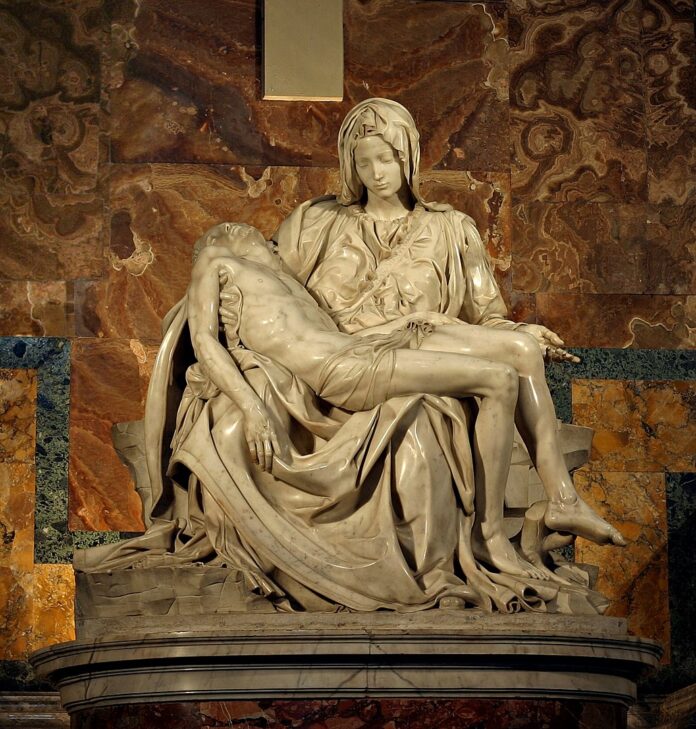The Pieta by Michelangelo stands as a testament to the remarkable artistic genius of the Italian Renaissance. Created by Michelangelo Buonarroti between 1498 and 1499, this exquisite sculpture has captivated audiences for centuries. Its profound emotional depth and technical brilliance attract the audience like a magnet. In this article, we will delve into the historical context, and describe the artwork in detail. Also, explore Michelangelo’s inspiration and interpretation, discuss controversies and impact, make comparisons with other artworks, and ultimately understand the enduring legacy of the Pieta.
Historical Context of the Pieta
During the Renaissance period, the world of arts underwent a great transformative shift. The artists started embracing naturalism, and humanism, and the classical ideas of art were revived once again. The Pieta is a depiction of the Virgin Mary cradling the lifeless body of Jesus Christ. It held a central place in the religious subject matter of the time. The Catholic Church, recognizing the power of visual narratives, commissioned numerous artworks to inspire devotion. And communicate theological concepts to the masses. Michelangelo’s Pieta is one of those commissioned artworks that is still inspiring devotion among the followers of Christianity.
Description of the Pieta
The Pieta is an awe-inspiring sculpture carved from a single block of Carrara marble. Standing at approximately 5 feet and 8 inches tall, it showcases Michelangelo’s exceptional skill in manipulating the medium. The composition is harmonious, with the lifeless Christ gently supported by the sorrowful Virgin Mary. Michelangelo’s masterful technique and attention to detail breathe life into the marble. Thus creating an illusion of soft flesh and flowing drapery that invites viewers to touch the sculpture’s delicate surface.
Michelangelo’s Inspiration and Interpretation
Michelangelo’s artistry was deeply influenced by his extensive knowledge of classical sculpture and his passionate devotion to his Catholic faith. In the Pieta, he captured not only the grief and anguish of the Virgin Mary. But also expressed his own spiritual and personal struggles. Through the juxtaposition of the youthful Virgin Mary and the lifeless Christ. Michelangelo conveyed a powerful message of sacrifice, compassion, and the universal human experience of loss.
Controversies and Impact
Like many masterpieces, the Pieta has faced controversies and challenges over the centuries. One notable controversy arose when it was incorrectly attributed to other artists due to its exceptional quality. Furthermore, the sculpture underwent restorations that sparked debates about the extent to which the original work was altered. Despite these controversies, the Pieta has left an indelible mark on art history. Thereby solidifying Michelangelo’s reputation as one of the greatest artists of all time.
Comparisons with Other Artworks
When comparing the Pieta with other sculptures by Michelangelo, such as his David or Moses. One can observe the distinct characteristics of his style, including the remarkable anatomical precision. And the ability to infuse marble with a sense of movement and emotion. Furthermore, comparing the Pieta with other depictions of the same subject matter by different artists provides insight into the individual artistic interpretations and the unique contributions of Michelangelo to this iconic theme.
Conclusion
The Pieta by Michelangelo remains an awe-inspiring masterpiece that transcends time and connects with the deepest emotions of humanity. Its remarkable craftsmanship, profound spiritual expression, and timeless beauty continue to inspire and captivate audiences around the world. As we gaze upon the delicate features of the Virgin Mary and the lifeless body of Christ, we are reminded of the power of art to touch our souls and evoke profound contemplation of the human experience.
In the end, the Pieta stands as an enduring testament to Michelangelo’s artistic genius and his ability to transform cold stone into a deeply moving portrayal of grief, compassion, and divine love. It reminds us of the enduring power of art to transcend time, speak to the depths of our hearts, and connect us with the beauty and complexity of the human spirit. The Pieta by Michelangelo will continue to inspire and leave an indelible mark on the world for generations to come.
And as always folks if you would like to read similar interesting and informative articles but in Hindi be sure to check out the Mojo Patrakar. Also, if you liked this article be sure to check out some other interesting articles on GGF such as The Thinker” by Auguste Rodin: An Icon of Contemplation and Human Expression.



